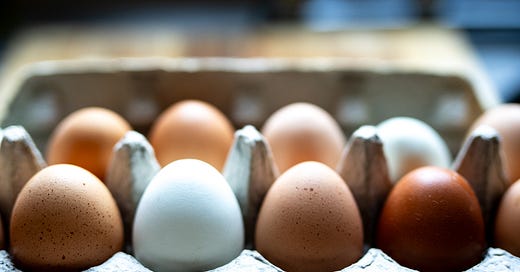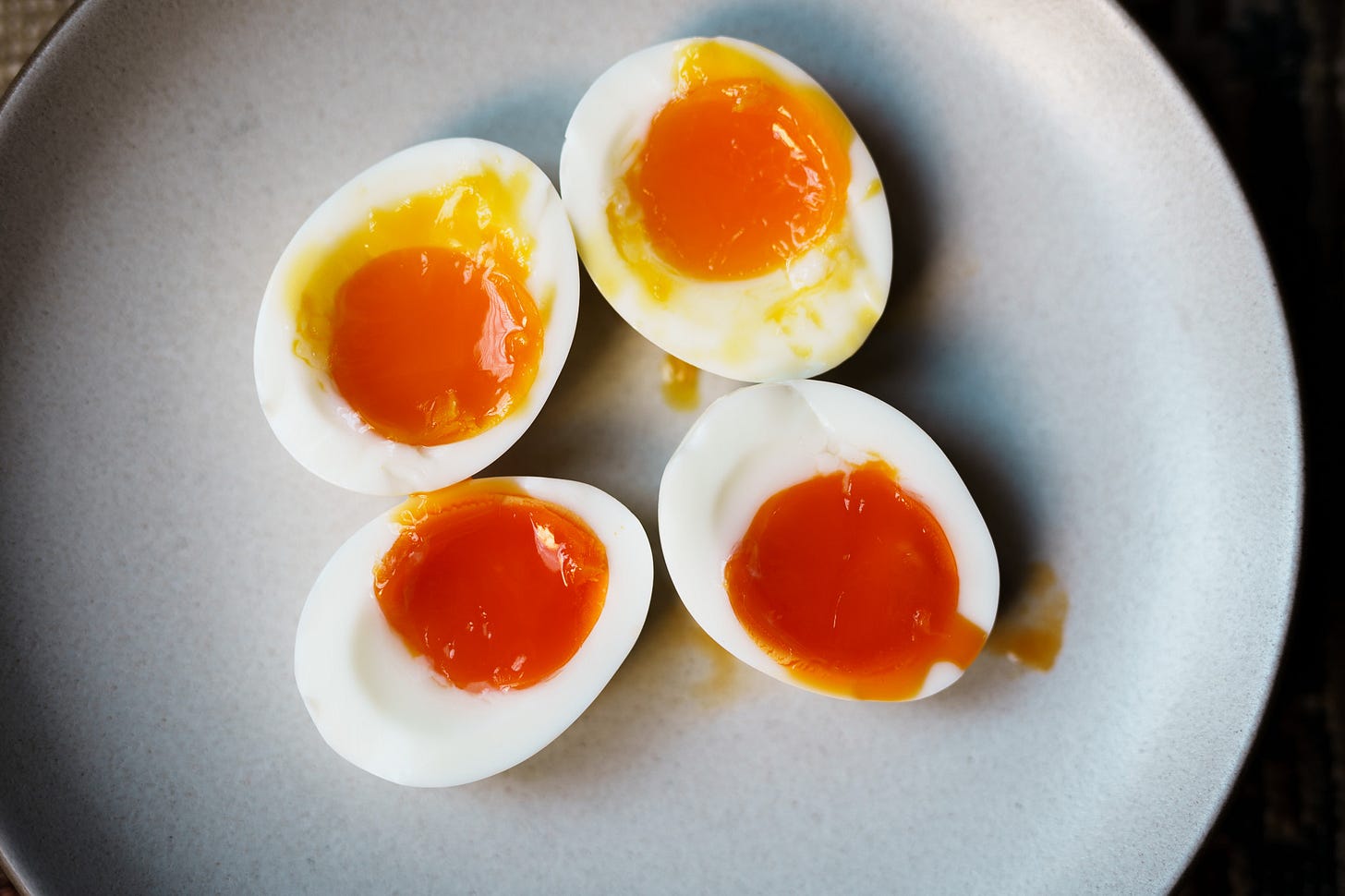If you haven’t tried an egg from Riverdog Farm, doing so may redefine the way eggs should really taste. My relationship with the Riverdog egg was born in the Chez Panisse kitchen. Served to service staff as a snack, fried, aboard a thinly sliced levain bread smeared with a squab liver mousse, it was the egg to ruin all eggs. One oozing bite and I instantly lost an appreciation for the ordinary Rock Island eggs that I was accustomed to. Light and bright whites were a canvas to the jammiest and richest of yolks with a depth of flavor that wasn't disturbingly reminiscent of the hen house. It was, beyond a doubt, the most delicious egg I had ever consumed.
A flurry of googles upon returning home that evening told the story of the Riverdog egg and revealed its cult-like following. From mockery to worship, an article in the New Yorker poked fun at the herd of Berkeley residents lining up for the divine eggs, inevitably praising them for their flavor and highlighting the unique farm that produces them.
When I received an early-morning cryptic close-up shot of a soft-boiled egg from my dad, with a blood orange jammy yolk and mention of a pastel blue shell, I was not surprised. A lifetime with Paul Bertolli and I have grown accustomed to close-up imagery of random food objects before dawn, my cock-a-doodle-doo. What surprised us initially was that this egg could be purchased for pennies on the Riverdog dollar from Costco. “Riverdog-like…. what gives?”
These Costco eggs are advertised as heirloom and free-range. “Amber yolks, taste the difference,” they slap on the packaging. Their blue color and marketing buzzwords reportedly lead to voracious consumption from Costco shoppers and stock depletion. People have fallen for the trap.
As it turns out, the egg market is deceptive and complex. Claims are thrown around like cage-free, humanely raised, and free-range, on cartons that cost three to thirteen dollars. Yolk and shell color falls anywhere from white to red, and to many prescribes quality. These Costco eggs, while blue-shelled, amber-yolked, and deceptively packaged, taste no different from other mass-produced lower-cost eggs you might find elsewhere.
So how do you navigate the egg labyrinth and emerge victorious with a delicious and sustainably raised prize for your morning toast?
It starts with understanding that chickens naturally graze and forage. They love insects, worms, vegetation, and seeds. Like most Americans, they love their protein, and will naturally seek it out. Chickens confined to small spaces and fed bags of cereal grains, corn, and soybean meal for protein, comprise the vast majority of our egg layers. Imagine telling your ribeye-a-day friend, relative, or neighbor that they would live out the rest of their existence in a cardboard box eating Luna bars… Because chickens are predisposed to graze and forage, a pasture-raised lifestyle is most natural, allowing them to play a productive role in fertilizing and managing the ecosystems to which they belong, all the while eating their preferred diet.
In California, we have the luxury of a year-round pasture-friendly climate. In the egg-producing capitals of the United States, however, pasture freezes over in the winter, and it is simply impossible to properly pasture birds year-round. Cage-free and free-range claims can be deceptive as the definition of a “cage”, or the lack thereof is not generous to the chicken, and freedom to range is not necessarily capitalized on by the birds. Choose pasture-raised where you can, but realize that it is not always a viable means of production, falling back on locality as a guide. Also consider that “pasture-raised” on its own carries no certification, and you must look for “certified humane” or “certified GAP” labels to corroborate husbandry claims.
Next, don’t be fooled by color, in shell or yolk. Shell color is entirely dependent on breed, and bears no direct relation to egg quality. The yolk color is similar. While it is true that pastured birds eating a diet of carotenoid-rich forage produce deep amber yolks. Two percent paprika by weight added to a standard agricultural supply feed can yield even deeper colors. One should be skeptical of claims like that of the Costco heirloom. “Amber yolks, taste the difference…” If you ate a diet of Cheerios and 2% paprika by weight, you too might begin to resemble Big Bird.
Finally, shop locally and ask questions. Local farmer's markets usually have eggs for sale, and you can ask the farmers about their methods. “What do your birds eat? Do they contribute to the agroecosystem of your farming operation? Do you feed them red powder?”
For reference and perhaps a biased golden standard, Riverdog laying hens eat better than I do during a busy week. In addition to pasture and insect forage, triticale (a wheat and rye hybrid), safflower, Cowgirl Creamery whey, leftover organic matter from fruit and vegetable production, and organic feed comprise their opulent avian diet. Araucana, Vega Brown, Rhode Island Red, White Leghorn, and Barred Rock birds make up their diverse flock and contribute to the beautiful pastel shades in the carton. Located in the Capay Valley, not far from my alma mater in Davis, they bring fantastic eggs to market. They also grow a variety of organic vegetables, fruits, and nuts. Unlike many other egg producers, their birds are rotated over 5-acre sections of pasture and cropland, and their egg production is symbiotic with their row crop operation.
The moral of the story is not easy to swallow. There is a right and wrong choice for your eggs, and it isn’t an easy one. Fortunately, you will be rewarded for the right choice in flavor and a contribution to the greater avian good. If you have the privilege of being able to be selective about your eggs, I urge you to do so. Be warned, an egg obsession that has you taking three methods of public transit to the egg source can be life-consuming and well deserving of Shouts and Murmurs mockery.






